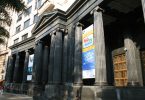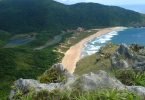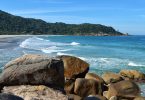If you are in São Paulo and would like to do a short trip, we are creating a lot of thematic tours! This one is the Short Trip São Paulo – Architecture Tour in Sao Paulo’s Historic Downtown
Presenting buildings with many different styles, shapes and sizes, Sao Paulo has a real outdoor cultural collection. Walking along downtown means to observe history being told through its constructions, concrete manifestations of the transformations of a village that until 1872 had little more than 30 thousand inhabitants and was restricted to the Historical Triangle (of which the vertexes are the Mosteiro de São Bento, Igreja de São Francisco and Igreja da Ordem Terceira do Carmo), until it was transformed into this current metropolis of 12 million inhabitants.
From the Pateo do Collegio, which reminds us of the colonization era, until the contemporary porch of Praça do Patriarca, passing through the stateliness of buildings such as the Municipal Theater and Altino Arantes, the tourist who arrives in Sao Paulo is easily attracted to the architecture – and a simple stroll through Sao Paulo streets already guarantees a fascinating experience.
Site of the International Biennial of Architecture (BIA), one of the main events of the segment in the world, Sao Paulo is extremely connected to the theme, and knowing the magnitude of all the buildings set throughout its extension is a task so complex as unveiling all the other secrets of this endless city. Because of this, the Sao Paulo City Hall, through Sao Paulo Turismo, developed this Architecture Tour in Sao Paulo’s Historic Downtown.
The trajectory gets together the representatives of the several styles developed in the city throughout its history – highlighting the work of famed architects – and still presents connections to facts and historical characters. You will get to know on foot the magnificent architecture of the center of our city, following our route suggestion that will go over 25 touristic landmarks.
Click in the Title of the landmarks for more information.
Main attractions
1. Mosteiro de São Bento – St. Benedict’s Monastery
It is one of the vertexes of the Historical Triangle; it is the fourth construction from Benedictine order in the site since 1600. This complex holds the Our Lady of As – sumption Basilica and Sao Bento School, which was de – signed in 1910 by the architect Richard Berndl, professor of Munich University, with internal decoration by the Dutch Benedictine monk D.
Adelbert Gresnicht. It is one of the few remaining in the world in Beuronese style – German artistic manifestation almost eradicated with the Second World War, which the main characteristic is the full integration between art and architecture. It is illustrative of Beuron the basilica interior, practically all garnished, from Mosteiro de São Bento the floor to the ceiling, with paintings, sculptures, stained glass and mosaics that match the Egyptian art elements, Byzantine and Roman. A curiosity: it was where Pope Benedict XVI stayed during his visit to Brazil in 2007.
Where: Largo São Bento, s/nº
When: Monday to Friday (except Thursdays):
6 am to the end of the mass started at 6 pm; Saturday and Sunday: 6 am to 12 pm and 4 pm to 6 pm. Thursday: church closes at 8 am and reopens at 11:30 am. Bakery shop: daily 7 am to 6 pm.
2. Edifício Martinelli – Martinelli Building
When it was opened, in 1929, it was the highest building in the world outside The United States, condition that was only lost in 1936. At first, designed by the Hungarian architect William Fillinger, from Vienna Fine Arts Academy, the project was a 12-floor construction that was changed by its own entrepreneur, the Italian commander Giuseppe Martinelli, who wanted to build a 30-floor building. The goal was achieved when he built his own mansion on the top of the building, demonstrating to the distrustful, that besides being so high, the construction was safe.
The shape of this building in beaux-art style presents recesses for a better ventilation and illumination, common in the big American hotels in that period, besides counting with the three basic divisions of classical architecture: base (the lowest part covered in granite), body (covered in a pink bulk that made the building sparkle at night) and cornice (the roof covered by windows called mansard).
Public visiting is allowed to the terrace (previous booking necessary at Saturdays).
Where: Rua Líbero Badaró, 504
When: Monday to Friday, from 09:30 am to 11 am and from 2:30 pm to 4 pm. Saturday, from 9 am to 1 pm.
3. Edifício Altino Arantes – Altino Arantes Building
One of Sao Paulo’s symbols, this Art Déco (from French origin, a short for arts décoratifs) skyscraper was opened in 1947, it was also once the highest building in the world outside The United States, 161 meters high, title that was lost only in 1953. Designed by architect Plínio Botelho do Amaral to be a bank headquarters, it follows the “wedding cake” shape, where the diameter of the floors of the building decrease at a certain point, and it has the flag of Sao Paulo State on its top . The luxurious lobby has a 13-meter candelabrum weighting 1.5 ton, besides a mural that shows the evolution of Sao Paulo’s economy since it’s early stages. The observatory on the top allows a 360º panoramic view and it is open for public visiting for free.
Where: Rua João Brícola, 24
When: Monday to Friday, from 10 am to 3 pm.
4. Banco de São Paulo – São Paulo Bank
Built from 1935 to 1938, it is one of the most beautiful and luxurious Art Déco buildings in the city. A work of architect Álvaro de Arruda Botelho. A visit is recommended to the beautifully decorated lobby: the floor is a mosaic of ceramic pastilles, dense granite tables decorated by crystals remind the old bank transactions, and the noble lobby in the mezzanine is completely covered with hardwood.
Born in the 1920´s, Art Déco was a manifestation of visual arts that wanted to break academic and historic styles, characterized by the modern decoration with geometric motifs, noble materials and simplicity of style.
Where: Praça Antônio Prado, 9
When: Monday to Friday, from 09 am to 04 pm
5. Centro Cultural Banco do Brasil – Bank of Brazil Cultural Centre
The former headquarters of Banco do Brasil in Sao Paulo city was built from 1923 to 1927, following a project of the architect Hipólito Gustavo Pujol Júnior, professor of Polytechnic School.
Since 2001, this building houses the Banco do Brasil Cultural Center, one of the most active and complete cultural spaces in Sao Paulo city, and is also part of the effort of the policy to revitalize Sao Paulo’s downtown.
In beux-art style, it mixes elements of neoclassicism, from the second French reign (Napoleon III style) and Italian Renascence. At the main entrance, right over the gate, there is a bust of Mercury – Roman God of Commerce. Inside,the main characteristic is the gap that follows all the floors, illuminated by a glass skylight made by the Conrado Sorgenicht House.
The basement safe of the former bank should also be highlighted.
Where: Rua Álvares Penteado, 112
When: Tuesday to Sunday, from 10 am to 08 pm.
6. Edifício Triângulo – Triângulo Building
It is called “Triangle” because it occupies a small plot in triangular shape. It is one of the works of the satellite-office that the famous Oscar Niemeyer kept in Sao Paulo in the 1950´s, under the supervision of architect Carlos Lemos.
Although it has lost some of its main characteristics, it was built on a Niemeyer project, eternalized Brazilian architect responsible for the public buildings in Brasilia and winner of Pritzker Prize (considered the Nobel Prize of architecture) in 1988. Due to the urban legislation of the period of the construction, its diameter decreases on the top floors, following the “wedding cake” shape.
The entrance of the building has a huge pastille mosaic of the artist Emiliano Di Cavalcanti, one of the most important names of Visual Arts in Brazil.
Where: Rua José Bonifácio, 24
7. Edifício Guinle – Guinle Building
The Guinle Building can be considered the first vertical building in the city. Built from 1913 to 1916, it was one of the first constructions of reinforced concrete in the country. At a time when the highest buildings were 3-storey buildings, this project of architects Hipólito Gustavo Pujol Júnior and Augusto de Toledo reached 8 floors and it is 36 meters high. The façade is ornamented in Art Nouveau style, with motifs of coffee branches and fruit, consigning the richness brought by the coffee economy.
Where: Rua Direita, 49
8. Caixa Cultural
Opened in 1939, by the president at that time, Getúlio Vargas, the former Sao Paulo headquarters of Caixa Econômica Federal follows the style that was characteristic of Estado novo, which was supposed to show the strength of Brazil under its political system. This thought used to follow the buildings of The Fascist Political System in Italy.
The building designed by Albuquerque & Longo office holds, since 1989, Caixa Cultural, a cultural center. The main highlight on its façade is the monumental Ionian black granite portico. Inside there is the magnificent stained glass window made by the Italian artist Henrique Zucca, which is six meters high and represents aspects related to the progress of Sao Paulo, and the huge skylight of colored stained glasses that covers the lobby.
Where: Praça da Sé, 111
When: Tuesday to Sunday, from 09 am to 09 pm.
9. The historical Jesuit church and school
This is the place where the city was founded with the celebration of the first Mass on January 25th 1554, and, later, the installation of the Jesuit School. In 1759, under determination of Pombal Marquis to banish the Jesuits and keep their belongings, Pateo started to house the government of São Paulo and then it was demolished and substituted by the new Government Palace. During the celebration of the Fourth Centenary of the city, in 1954, the State gave back the building to the Companhia de Jesus (The Jesus Company) so that the former colonial architecture school could be rebuilt in 1979. There are still walls and foundations from the sixteenth century made of rammed earth.Today, Pateo do Collegio houses the Anchieta Priest Museum and Chapel (who was one of the founders of the city) which has a collection of approximately 700 objects, many belonging in their origin to the former Jesuit School and Church.
Where: Pátio do Colégio, 2
When: Tuesday to Sunday, from 9 am to 4 pm. Guided Tours (pre-booked): Tuesday to Friday, from 9 am to 4 pm.
10. Tribunal de Justiça – First Court of Civil Jurisdiction
This peculiar building in Art Déco style presents ornaments inspired in Maian architecture, base with a monumental Doric portico and cornice crowned by two semi-domes. Designed in 1933 by the architect Felisberto Ranzini and opened in 1937 as the Stock Exchange headquarters; later it housed the State Farms Bureau and since 1977 it is occupied by the First Court of Civil Jurisdiction.
Where: Pátio do Colégio, 73
When: Monday to Friday, from 12:30 pm to 7 pm.
11. Secretaria da Justiça – Justice Department
The two buildings designed by Ramos de Azevedo are almost twins in neoclassical style. The building 184, on the right is the first work of the famous architect in the city of Sao Paulo: it was built from 1881 to 1891 to house the State Department of Finance and Treasury. The building 148 – more garnished – was opened in 1896 as the State Agriculture Department. Both have internal yards covered by skylights held up by artistic iron frames and both have Corinthian columns (the most ornamental from the Greek and Roman architectonic order) in their façades. Today, they both house Sao Paulo State Department of Justice.
Where: Pátio do Colégio, 148 e 184
When: Monday to Friday, from 8 am to 6 pm.
12. Solar da Marquesa de Santos – Solar of Santos Marquise
Construction dating to half of the eighteenth century – originally in colonial style – it has been renovated several times and now has a neoclassic facade. Inside there are archaeological windows on the walls that exposes the different interventions done during its existence, since the former constructive techniques (like rammed earth, wattle and daub and French pisé), until the modern ones, in brickwork. It is the oldest remnant of urban residential architecture in Sao Paulo city.For more than 30 years it was the home of Santos Marquise, a woman ahead of her time, of great influence in Sao Paulo society and politics, famous for her relationship with Dom Pedro I Emperor. Today, the Solar is the headquarters of the Sao Paulo City Museum, and it was thoroughly restored in 2011.
Where: Rua Roberto Simonsen, 136
When: Tuesday to Sunday, from 9 am to 5 pm.
13. Igreja da Ordem Terceira do Carmo – Third Order of Mount Carmel Church
Since 1592 this place has been occupied by the Carmelites, constituting the other vertex of the Historical Triangle. First it was occupied by Our Lady of Mount Carmel Church and Convent, only between 1747 and 1758 that the Third Order of Mount Carmel Church was built, forming a set with the preexisting buildings. In 1928, when the Our Lady of Mount Carmel Church and Convent was destroyed, The Third Order of Mount Carmel Church was the only remnant of this set. Made of rammed earth, the internal part of this colonial temple presents rich ornamentation from eighteenth and nineteenth centuries, with a rococo altar, friar Jesuíno do Monte Carmelo paintings and frontispiece, which is the main entrance of the façade of the building, made by Joaquim Pinto de Oliveira – nicknamed Tebas.
Where: Avenida Rangel Pestana, s/n,
(on the corner of Rua do Carmo)
14. Palácio da Justiça – Palace of Justice
Designed in 1911 by Domiziano Rossi and Felisberto Ranzini architects, inspired in Palazzo di Giustizia in Rome, Italy, this work from the Technical Office Ramos de Azevedo was opened only in 1933. In beaux-art style, influenced by Neo-renaissance, the façade presents luxurious finishing and it is garnished with figures, caryatids (female statues used as columns) and symbols of the judiciary. Inside, the highlight is the Jury Plenary, overlaid with sidings (overlay to internal walls with decorative purpose) made with hardwood and the ceiling garnished and crowned by a skylight in the center.
It houses permanent and temporary exhibitions kept by the Court of Law Museum – today headquartered at Conde de Sarzedas Stately House (100 Conde de Sarzedas treet).
Where: Praça Clóvis Bevilacqua, s/n.
When: Monday to Friday, from 10 am
15. São Paulo Cathedral
Designed in 1912 by German architect Maximillian Hehl and opened still uncompleted in 1954, its architecture basically neo-gothic fits the beaux-art style because it has a huge dome inspired in the Renaissance. Monumental construction with the capacity for more than 8 thousand people; 16 towers (two of them reaches 97 meters high) and 54 stained glass windows, there is, under the main altar, a crypt where Sao Paulo´s bishops and archbishops are buried, besides historical characters such as Tibiriçá Chieftain and Feijó Regent. It is important to highlight the greatness of the interior and the huge amount of stained glass windows: there are national ones made by Conrado House and European ones made by artists such as Quentin, Avenali, Fontana and Max Ingrand. The ornamentation that has motifs of Brazilian fauna and flora like the armadillo, the toucan and cocoa is a peculiar trait.
Where: Praça da Sé
When: Monday to Friday, from 8 am to 7 pm. Saturday, 8 am to 5 pm. Sunday, 8 am to 1 pm and 3 pm to 6 pm.
16. Escola de Comércio Álvares Penteado – Álvares Penteado Business School
Built from 1907 to 1908, designed by Swedish architect Carlos Ekman, this building is a Sezession style construction, an Austrian localized form of Art Nouveau style. Born in the end of the nineteenth century, the Art Nouveau made opposition to the academic and historic styles dominant then, so gaining this name which can be translated as “new art”. Its main characteristic is the inspiration in organic forms and the curves of nature.
Where: Largo São Francisco, 19
When: Monday to Wednesday, from 12 pm to 9 pm. Thursday and Friday, 12 pm to 8 pm.
17. Faculdade de Direito Largo São Francisco – Law School
One of the most important institutions in the historical development of the city, the Law School was set up in this place in 1828, bringing effervescence and intellectuality to a calm Sao Paulo at that time. At first it was in the Franciscan Convent, demolished in 1932 to be replaced by this construction: a neo-colonial building designed by architect Ricardo Severo. Inside, it can be highlighted the stained glass windows made by Conrado Sorgenicht and the chamber of former professor Julio Frank, located in the yard that was safe from the demolition of the former convent.
Where: Largo São Francisco, s/n.
When: Monday to Friday, from 7 am to 8 pm.
18. Conjunto Franciscano – Franciscan Set
In an area occupied by the Franciscans since 1642, after donation of Council of Sao Paulo, this set of two baroque churches in rammed earth is another vertex of the Historical Triangle. Igreja de São Francisco (Saint Francis Church 133 on the left) was built from 1642 to 1647, whose convent was the place where lived the first Brazilian Saint: Saint Friar Galvao. He was transferred to it in 1762. As for Igreja das Chagas do Seráfico Pai São Francisco (The Wounds of Seraphic Father Saint Francis Church 173, on the right), it was opened in 1787, after additions to the former chapel whose origins date back to 1676. With a rock base and rococo interior, it has gold veneer altars and pieces from the 17th century, such as altarpieces by Luiz Rodrigues Lisboa and paintings by José Patrício da Silva Manso.
Where: Largo São Francisco, 133 e 173
When: Igreja de São Francisco – Daily, from 07:30 am to the end of the mass started at 06:30 pm (6 pm on tuesdays) / Igreja das Chagas: closed (under restoration).
19. Edifício Barão de Iguape – Barão de Iguape Building
Designed by Gordon Bunshaft, American architect winner of the Pritzker Prize, this modernist building of 133 meters high was built from 1956 to 1959 as headquarters of a bank. It is an “international style” building, which represented simple lines, minimalism (characterized by the elimination of all kinds of ornaments) and volumetric lightness. The name of the building reminds the fact that this same plot was previously occupied by the solar of Baron of Iguape (Antonio da Silva Prado, in noble title given by the Emperor Dom Pedro II).
Where: Rua São Bento, 125
20. Igreja de Santo Antônio – Saint Anthony Church
From the late 16th century, this is the oldest church in São Paulo’s downtown – the first references to it are from 1592. There were many renovations and additions until its neo-classic façade we see now. In the last restoration, interventions from previous periods were found. It was chosen to recover the baroque characteristics, and today, there are paintings from the 17th century, besides de rococo style altar from 1780. It housed the Franciscan order in the 17th century before the construction of Sao Igreja de Santo Antônio Francisco Church, as well as the Sisterhood of Our Lady of the Rosary of White Men in the 18th century.
Where: Praça do Patriarca
When: Monday to Friday, from 7 am to 6 pm. Saturday, from 7 am to 9:30 am and from 5:30 pm to 6:30 pm. Sunday, from 8 am to 10:30 am and from 5:30 pm to 6:30 pm.
21. Pórtico da Praça do Patriarca – Patriarch Square Portico
A Contemporary work by the architect Paulo Mendes da Rocha – winner of Pritzker Prize in 2006 – this portico designed in 1992 covers the entrance to Prestes Maia Gallery. It has a metallic structure and a 40-meter gap; it was concluded only in 2002. The Prestes Maia Gallery is an underground passage that connects Praça do Patriarca to Vale do Anhangabau, and has exhibitions and works of art distributed on its three floors
Where: Praça Patriarca
22. Edifício Sampaio Moreira – Sampaio Moreira Building
Opened in 1924, it is considered to be the first skyscraper of the city, it is 54 meters high and it has 14 floors. It was elaborated in Louis XVI style by the architect Cristiano Stockler das Neves, it kept the title of the highest building in the city until the opening of The Martinelli Building. The cornice of the façade has a fake mansard and a pergola – these high parallel beams used to con – trol the illumination of the environment. On the ground floor there is the traditional Casa Godinho, grocery store opened in 1888 that used to be in Praça da Sé.
Where: Rua Líbero Badaró, 346
23. Headquarters of São Paulo City hall
Since 2004 it is the headquarters of São Paulo City hall, but it was inaugurated in 1939 to be the headquarters of the biggest industrial conglomerate of Brazilian history: Francisco Matarazzo United Industries. Using elements of classic inspiration, besides the austerity and monumentality characteristic of the fascist style, it has the façade completely covered in Roman travertine marble. It was designed by the Italian dictator Benito Mussolini’s favorite architect, the also Italian Marcello Piacentini. The highlight is the garden on the top of the building.
Where: Viaduto do Chá, 15
When: Monday to Friday, from 8 am to 8 pm.
24. Alexandre Mackenzie Building
Opened in 1929, it is a rare construction of American beaux-art architecture in Brazil. Monumentality, strong neo-classic inspiration, use of colonnade (series of columns) in its façade and the use of rustic and heavy materials and colors on the first floor are characteristics of this type of architecture. All the work of lumber and joinery was done by the acclaimed Lyceum of Arts and Crafts of São Paulo. It was designed by the architect William Proctor Preston to be headquarters of the Canadian São Paulo Tramway, Light and Power Company – one of the most influential companies in the urban development of São Paulo, which worked on the generation and distribution of electric power, and public transportation by tramways. Since 1999, it is the place of Shopping Light Mall.
Where: Rua Cel. Xavier de Toledo, 23
When: Monday to Friday, from 9 am to 9 pm. Saturday, from 9 am to 8 pm. Sunday, from 11 am to 06 pm.
25. Theatro Municipal de São Paulo – São Paulo Municipal Theatre
It was designed in 1903 by architects Domiziano Rossi and Claudio Rossi, from the Ramos de Azevedo office, and it is a monumental construction in beaux-art style. Paintings in gold, embossed details and splendid stairways make the theater one of the most ornamented buildings in Sao Paulo, and this splendor was improved by the restoration in 2011. The auditorium, where great names of worldwide art have been, seats about 1,600 people. Opened in 1911, it was stage to operas, concerts, and important events, among them, the revolutionary Modern Art Week of 1922 – an event that indicated the rupture of national art to the aesthetical ideals of the 19th century, consolidating Brazilian modernism.
Where: Praça Ramos de Azevedo
When: Monday to Saturday, from 10 am to 7 pm. Previous online booking necessary for guided tours.
Information from website: Cidade de São Paulo



































